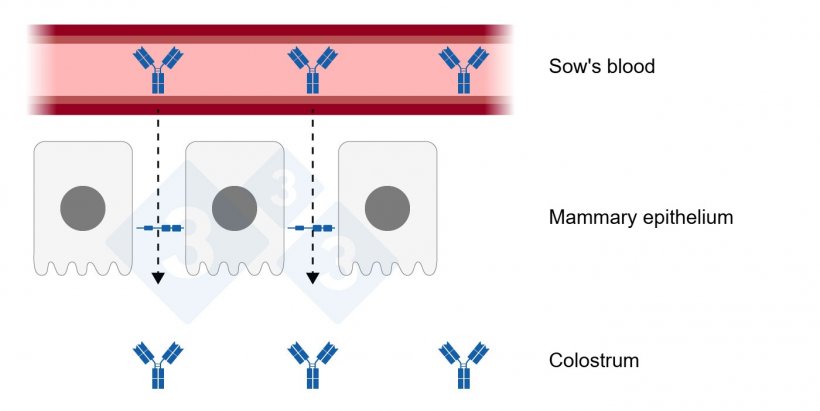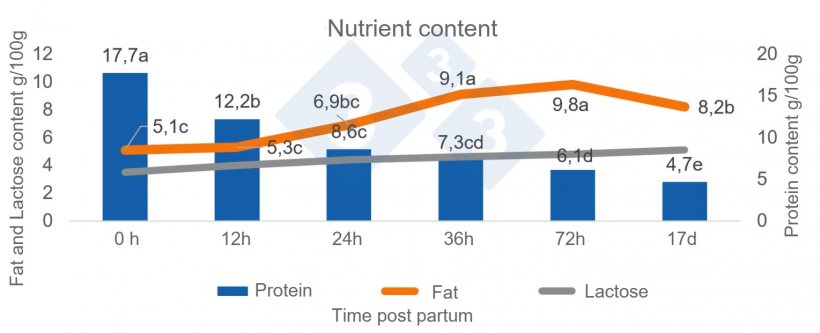Colostrum plays a crucial role in the early life of piglets, providing the energy, nutrients, and immune support needed for survival, growth, and health. However, the yield and quality of colostrum among sows are highly variable. Unlike milk production, colostrum yield is influenced primarily by sow-specific factors rather than litter size or piglet suckling intensity. An adequate intake of colostrum is critical, as it directly impacts piglet survival, health, and growth, both immediately after birth and throughout their early development. This article explores the complexities of colostrum production, with a focus on how we can enhance its quality and consistency to support the well-being and performance of piglets.
Colostrum, transient milk and mature milk: stages and differences
Colostrum:

Most of it is produced before parturition and lasts 24hs after the onset of farrowing. It is characterized by having a high protein content mainly driven by its content of immunoglobulins.
The most prominent immunoglobulin is IgG which can pass through the mammary epithelial cells as the tight junctions are not strong at that point in time (Figure 1). Neither it’s volume or weight are linked to litter size or suckling effect, on the contrary it is linked to the individual which can make its content between sows variable (Quensel 2011).

Transient Milk:
Starts to appear between 24hs and 34hs from farrowing. After 34hs transient milk is secreted and it is officially referred as the onset of lactation or second stage of lactogenesis. The protein content is significantly different from the first hours of colostrum, and as time progresses it differentiated even further as seen on Figure 2 (Theil et al., 2014)
Mature Milk:
It is different from colostrum by having less protein content, more fat and energy, which helps piglets grow and thrive. Its production is stimulated by the suckling effect of the litter.

Colostrum intake: is there a minimum recommended?
An average piglet weighing 1.4 kg at birth requires approximately 250 g of colostrum, or 180 g per kilogram of body weight (Quensel 2012), to reduce the risk of mortality, provide essential passive immunity, and support slight weight gain. Quesnel et al. (2012) suggests that at least one-third of sows fail to produce enough colostrum to meet the needs of their litter, underscoring the critical need to address colostrum insufficiency for improved piglet survival and health outcomes.
Colostrum production and quality
As reported by several authors, colostrum quantity does not depend on litter size but on the individual sow. Therefore with hyper prolific sows widely used, having a more concentrated colostrum in terms of immunoglobulin content is desirable. Sow’s colostrum contains predominantly IgG.
When it evolves to mature milk, the main immunoglobulin is IgA as shown in Table 1 (Theil et al., 2014). Immunoglobulin A has a crucial role in protecting the gastrointestinal tract and preventing diarrhea during the neonatal period and throughout suckling. Therefore any strategies that can help with increasing IgG in colostrum whilst also increasing IgA in mature milk will be desirable.
Table 1: Contents of immunoglobulins in colostrum and mature sow milk.
| Early colostrum | Mature milk | |
|---|---|---|
| IgG (total) (mg/ml) | 61.8 | 1.6 |
| IgA (mg/ml) | 11.3 | 4.1 |
| IgM (mg/ml) | 3.8 | 1.5 |
Theil et al., (2014) modified after Butler and Kehrli (2005)

One widely used practice to increase colostrum quality, is to vaccinate gilts and sows 3-4 weeks pre farrowing which leads to an increase of immunoglobulins and specific protection against particular diseases present on the farm.
Another option is to look at certain additives which can be used to increase colostrum quality. Quesnel and Farmer (2019) summarized different nutritional additives which can have a potential impact in colostrum, several of which contain beta glucans as immune stimulators.
As seen on the previous article, we know that beta glucans can boost vaccinal response which will help increase the number of immunoglobulins in blood and consequently in colostrum, thus helping the bottom third of sows which will have insufficient colostrum quantity. Having a supplement that can help increase the number of immunoglobulins in blood pre farrowing that can pass through the mammary gland during colostrogenesis seems to be a good area of opportunity to effortlessly increase passive immunity.
De Carvalho et al., (2023) conducted a trial to investigate this and fed beta glucans from day 85 of gestation and through lactation. They saw an increase of 24.9% in colostrum production (p<0.05), which lead to a significantly higher weight gain within 18hs of birth, 34g which represented 50% increase from the control group (P<0.05). Quantity was not the only parameter affected by the treatment. Immunoglobulin content in colostrum significantly increased by 16% in IgG and IgM content, whilst they’ve seen a numerical increase in IgA content (p-value =0.069). Another reflection of the increase in colostrum quality was the amount of immunoglobulins in piglet serum which was significantly higher with 51.25% increase of IgG, 120.19% of IgA and 144.78% of IgM, effectively adding another half to the IgG content in piglets.
Conclusions
Improving colostrum quality is essential to not only increase performance, but also continue on our antibiotic reduction quest, having healthier animals, raised in a sustainable way. Beta glucans are an excellent bioactive compounds that can help us enhance passive immunity in a profitable and practical way.



